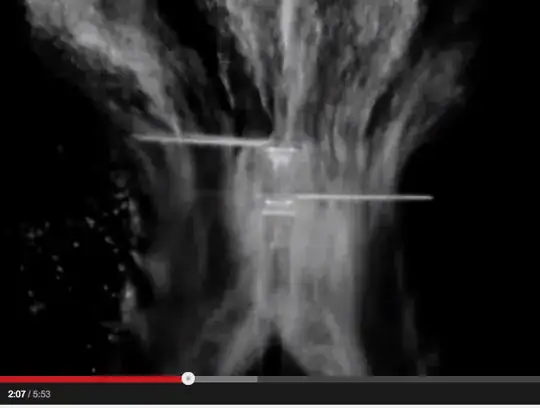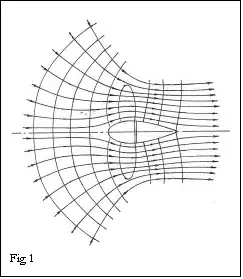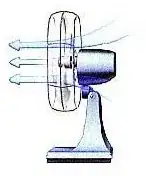Why is it that when you drop paper behind a fan, it drops, and is not blown/sucked into the fan, whereas if you drop paper in front of a fan, it is blown away?
3 Answers
There is a YouTube video that visualizes the air flow around a propeller for various configurations. I caught a screen shot of a moment that more or less shows what is going on:

As you can see, this happens at 2:07 into the clip - this happens to be for a dual rotor configuration (two counter rotating blades) but the principle is the same.
Behind the rotor (above, in this picture) the air is moving slowly. Air over a wide range of area is drifting towards the rotor, where it is accelerated.
I will leave it up to others to describe the mathematics behind this contraction - but I thought visualizing the flow would at least confirm your observation that it is indeed slower behind the fan, and faster in front of it. In other words - it pushes, but doesn't suck.
A better image showing the flow lines around the propeller is given at this article about the mechanics of propellers

As the pressure is increased, the flow velocity goes up and the flow lines end up closer together (because of conservation of mass flow). This gives the flow the asymmetry you observed. But it's still more intuitive than rigorous...
AFTERTHOUGHT Hot Licks made an excellent observation in a comment that I would like to expand on. The air being drawn towards the fan is moving in the pressure differential between the atmosphere at rest, and the lower pressure right in front of the fan blades. The pressure gradient is quite small, so the air cannot flow very fast - and it has to be drawn from a wide region to supply the mass flow. After impact with the blade (or at least after "interacting" with the blade), the air has a LOT more momentum that is directed along the axis of the fan (with a bit of swirl...). This higher momentum gives the air downstream of the fan its coherence as can be seen in the diagram.
- 119,981
Here's a standard fan with some (hard to see) arrows indicating air flow.

The fan works by pulling air in and then making it move faster. The air flow behind the fan is slow moving and wide (you can see the arrows behind the fan coming from above and below the fan blades) whereas the air flow in front of the fan is fast moving and narrow (which follows from the conservation of mass flow.
- 29,127
Think about the air around the fan at any given time:
The amount of air flowing into the fan must equate to the air flowing out of the fan.
The amount of air that passes through an area in a given time is related to the velocity of the air i.e. the faster the air is moving, the more air that can flow through a fixed area/hole/slot.
The fan blades apply a force in order to boost the velocity of the air in order to 'blow'. Hence, the flux of air through the disc located at the fan blades must be equivalent behind and in front of the fan (continuity condition).
Your observation is that the air behind the fan is moving slower than the air in front of the fan. If we were confined to pulling air from directly behind the fan enclosed in a cylinder with cross-sectional area equal to the fan blade coverage, then the air moving behind the fan would need to move as fast as the air in front of the fan to satisfy our continuity condition.
Therefore, the fan must be pulling air from a larger area behind the fan than the output air. If we think about this as a volume, it would be some sort of expanding cone as shown in diagrams you see of the air flow.
- 91